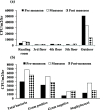Prevalence and antibiogram of coagulase negative Staphylococci in bioaerosols from different indoors of a university in India
- PMID: 32677881
- PMCID: PMC7364608
- DOI: 10.1186/s12866-020-01875-8
Prevalence and antibiogram of coagulase negative Staphylococci in bioaerosols from different indoors of a university in India
Abstract
Background: Staphylococci species are the major constituents of infectious bioaerosols, particularly methicillin-resistant Staphylococci (MRS) have serious health impacts. Here, the bacterial burden was quantified, especially prevalence of MRS in bioaerosols collected from indoors of Dr. B.R. Ambedkar Central Library (DBRACL) and Central Laboratory Animal Resources (CLAR) of Jawaharlal Nehru University, New Delhi, India. Air samplings from DBRACL and CLAR were done using the settle plate method and SKC biosampler, respectively.
Results: This study showed a maximum 6757 CFU/m2/hr of bacterial load in the DBRACL reading room, while unacceptable bacterial loads (> 1000 CFU/m3 of air) at different sites of CLAR. Further, at both the sampling sites the predominance of coagulase negative Staphylococci (CNS) was observed. A total 22 and 35 Staphylococci isolates were isolated from DBRACL and CLAR bioaerosols, respectively. Majority (16/22) of the Staphylococcal isolates from DBRACL belonged to human-associated Staphylococci where S. haemolyticus (5/22) was the most dominating species. However, in CLAR facility centre, animal-associated Staphylococci (19/35) were dominating, where S. xylosus (12/35) was the most dominating species. Further, antibiotic sensitivity tests revealed 41% MRS and 73% multidrug resistant (MDR) among airborne Staphylococci from DBRACL indoor bioaerosols. Similarly, in CLAR facility, approximately, 66% Staphylococci isolates were methicillin resistant, out of which 2 isolates showed high MIC value ≥ 16 μg/mL. Further, we confirmed the presence of 49% multidrug resistant Staphylococci in the indoor air of CLAR facility.
Conclusions: This study suggested that the exposure of workers and students in CLAR to such a high concentration of drug-resistant Staphylococci should not be undermined, as these bacterial concentrations are the direct representative of inhalable particulate matter (PM2.5) as per collection procedure. Simultaneously, passive sampling from DBRACL assessed the risks due to microbial contamination in particle agglomerates, which may deposit on the crucial surfaces such as wounds/ cuts or on the frequently used items.
Keywords: Bioaerosol; CNS; Infectious bioaerosol; Methicillin-resistance; Multi-drug resistance; Staphylococci.
Conflict of interest statement
The authors declare that they have no competing interests.
Figures




Similar articles
-
Prevalence and molecular characterization of multidrug-resistant coagulase negative staphylococci from urban wastewater in Delhi-NCR, India.Arch Microbiol. 2024 Sep 10;206(10):399. doi: 10.1007/s00203-024-04124-y. Arch Microbiol. 2024. PMID: 39254720
-
High prevalence of methicillin-resistant coagulase-negative staphylococci isolated from a university environment in Thailand.Int Microbiol. 2017 Jun;20(2):65-73. doi: 10.2436/20.1501.01.286. Int Microbiol. 2017. PMID: 28617524
-
Patterns of multidrug resistance among methicillin-resistant hospital isolates of coagulase-positive and coagulase-negative staphylococci collected in the international multicenter study RESIST in 1997 and 1998.Microb Drug Resist. 2000 Fall;6(3):199-211. doi: 10.1089/mdr.2000.6.199. Microb Drug Resist. 2000. PMID: 11144420
-
Detection and characterization of methicillin-resistant and susceptible coagulase-negative staphylococci in milk from cows with clinical mastitis in Tunisia.Int J Antimicrob Agents. 2018 Dec;52(6):930-935. doi: 10.1016/j.ijantimicag.2018.07.026. Epub 2018 Aug 3. Int J Antimicrob Agents. 2018. PMID: 30077662
-
Air quality and mental illness: role of bioaerosols, causal mechanisms and research priorities.BJPsych Open. 2024 Sep 19;10(5):e149. doi: 10.1192/bjo.2024.724. BJPsych Open. 2024. PMID: 39295307 Free PMC article. Review.
Cited by
-
A comprehensive review of microbial contamination in the indoor environment: sources, sampling, health risks, and mitigation strategies.Front Public Health. 2023 Nov 23;11:1285393. doi: 10.3389/fpubh.2023.1285393. eCollection 2023. Front Public Health. 2023. PMID: 38074709 Free PMC article. Review.
-
Prevalence and molecular characterization of multidrug-resistant coagulase negative staphylococci from urban wastewater in Delhi-NCR, India.Arch Microbiol. 2024 Sep 10;206(10):399. doi: 10.1007/s00203-024-04124-y. Arch Microbiol. 2024. PMID: 39254720
-
Molecular Characterization of Cefoxitin-Resistant Coagulase-Negative Staphylococci From Frequently Touched Surfaces of Hospital and Urban-Built Environments of Central India.Can J Infect Dis Med Microbiol. 2025 Feb 5;2025:5766823. doi: 10.1155/cjid/5766823. eCollection 2025. Can J Infect Dis Med Microbiol. 2025. PMID: 39949528 Free PMC article.
-
Bioaerosol assessment in indoor and outdoor environments: a case study from India.Sci Rep. 2023 Oct 23;13(1):18066. doi: 10.1038/s41598-023-44315-z. Sci Rep. 2023. PMID: 37872255 Free PMC article.
References
-
- Cyprowski M, Ławniczek-Wałczyk A, Gołofit-Szymczak M, Frączek K, Kozdrój J, Górny RL. Bacterial aerosols in a municipal landfill environment. Sci Total Environ. 2019;660:288–296. - PubMed
-
- Agodi A, Auxilia F, Barchitta M, Cristina ML, D'Alessandro D, Mura I, Nobile M, Pasquarella C, Avondo S, Bellocchi P. Operating theatre ventilation systems and microbial air contamination in total joint replacement surgery: results of the GISIO-ISChIA study. J Hosp Infect. 2015;90:213–219. - PubMed
-
- Létourneau V, Nehmé B, Mériaux A, Massé D, Cormier Y, Duchaine C. Human pathogens and tetracycline-resistant bacteria in bioaerosols of swine confinement buildings and in nasal flora of hog producers. Int J Hyg Env Heal. 2010;213:444–449. - PubMed
Publication types
MeSH terms
Substances
Grants and funding
LinkOut - more resources
Full Text Sources
Medical
Molecular Biology Databases

